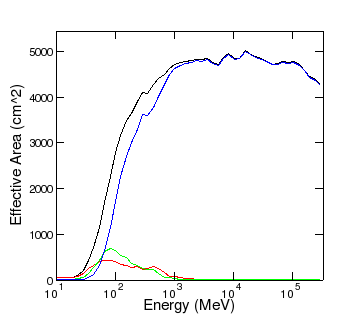...
- Separate IRFs for each class will need to be generated, but instead of generating the IRFs using events that have a minimum CTBClassLevel, as we currently do, the IRFs will need to be generated for significantly smaller numbers of events for which CTBClassLevel is a specific value, e.g., CTBClassLevel==1, CTBClassLevel==2, CTBClassLevel==3. In this case, only the IRFs for CTBClassLevel==3 would be the same as an original Pass 5 set (diffuse class). There would be substantially fewer events for CTBClassLevel==0 or 1. Here is a plot of the effective area for the front section for the three CTBClassLevel values using the AllGamma_v13r9p3_Lyon data:
The smaller number of events overall and the significant dearth of any events above 1 GeV will cause difficulties for characterizing the PSF and energy dispersion for the EVENT_CLASS 0 and 1 values.EVENT_CLASS
CTBClassLevel cut
curve
number of events
0
==1
red
0.27 M
1
==2
green
0.24 M
2
==3
blue
4.30 M
0,1,2
> 0
black
4.81 M
- Since each event has a unique set of IRFs, gtdiffrsp will only have to be run once regardless of the downstream selections on EVENT_CLASS.
- The gtselect interface will need to be modified. I propose two new sets of parameters to handle selections on the EVENT_CLASS and CONVERSION_TYPE columns separately:
Either one of these will produce a set of events that are the same as would be produced using "CTBCLASSLEVEL > 1 && CONVERSION_TYPE==0" in fcopy or fselect. It is anticipated that users will only want to specify a range of EVENT_CLASS values and not wish to make non-contiguous selections such as "EVENT_CLASS==0 && EVENT_CLASS==2". It is likely that users will not want to make selections excluding the higher event classes, so evclsmin may be all that is needed. These will be hidden parameters and the defaults will be to make no selections on EVENT_CLASS or CONVERSION_TYPE.Code Block gtselect evclsmin=1 evclsmax=2 convtype=0 gtselect evclsmin=1 convtype=0
- Depending on the number of event classes included, gtexpmap will run correspondingly slower. Since the Psf integral over the ROI is by far the most cpu-intensive part of the gtexpmap calculation and since it has to be performed separately for each set of IRFs, event selections that include three event classes (the proposed default for Pass 5) will take three times as long as the current implementation. (There may be a way of mitigating this by having the different PSFs share the cached values of the ROI integrals.)
- In order to enable backwards compatibility with old FT1 files, a new keyword has been introduced to the EVENTS HDU: EVCLSVER. If this is equal to "0" or missing, then the old implementation is assumed. If it is "1", then the new scheme will be used.
- The format of the IRF files will change slightly. In order to facilitate these changes, multiple event classes that partition the data will be contained within a single file and stored as separate rows in the binary tables. In keeping with the the organization of CALDB wherein the front and back sections of the LAT are different "detectors", separate IRF files for front and back IRFs will be maintained. Here is an example header for this new format. The only difference from the old headers is that NAXIS2=3, indicating IRFs for three event classes are present.
- The IRF names to be used by the tools via the irfs parameter will be standardized. These will be determined from the information in the caldb.indx file. I've written a tool in the irfs/irfLoader package that will allow users to discover the valid available names:
Setting chatter=3 or greater will cause the tool to print the irfs that are available prior to Pass 4. The P5_v13 IRFs show the Pass 5 IRFs under the new scheme. Any one of these values should be valid inputs to gtrspgen. However, since the DSS keywords will be parsed by the Likelihood tools, only the combined versions should be used, e.g., irfs=P5_v13 is ok, irfs=P5_v13_0::FRONT is not.Code Block ki-rh2[jchiang] gtirfs P5_v13 ( = P5_v13_0::FRONT + P5_v13_0::BACK + P5_v13_1::FRONT + P5_v13_1::BACK + P5_v13_2::FRONT + P5_v13_2::BACK ) P5_v13_0::BACK P5_v13_0::FRONT P5_v13_0_diff ( = P5_v13_0_diff::FRONT + P5_v13_0_diff::BACK ) P5_v13_0_diff::BACK P5_v13_0_diff::FRONT P5_v13_0_source ( = P5_v13_0_source::FRONT + P5_v13_0_source::BACK ) P5_v13_0_source::BACK P5_v13_0_source::FRONT P5_v13_0_trans ( = P5_v13_0_trans::FRONT + P5_v13_0_trans::BACK ) P5_v13_0_trans::BACK P5_v13_0_trans::FRONT P5_v13_1::BACK P5_v13_1::FRONT P5_v13_2::BACK P5_v13_2::FRONT PASS4 ( = PASS4::FRONT + PASS4::BACK ) PASS4::BACK PASS4::FRONT PASS4_v2 ( = PASS4_v2::FRONT + PASS4_v2::BACK ) PASS4_v2::BACK PASS4_v2::FRONT PASS5_v0 ( = PASS5_v0::FRONT + PASS5_v0::BACK ) PASS5_v0::BACK PASS5_v0::FRONT PASS5_v0_DIFFUSE ( = PASS5_v0_DIFFUSE::FRONT + PASS5_v0_DIFFUSE::BACK ) PASS5_v0_DIFFUSE::BACK PASS5_v0_DIFFUSE::FRONT PASS5_v0_TRANSIENT ( = PASS5_v0_TRANSIENT::FRONT + PASS5_v0_TRANSIENT::BACK ) PASS5_v0_TRANSIENT::BACK PASS5_v0_TRANSIENT::FRONT ki-rh2[jchiang]
- Packages affected:
- Likelihood
- pyLikelihood
- dataSubselector
- irfs/latResponse
- observationSim
- fitsGen
- map_tools (? no idea since it probably doesn't use the standard interface to the response functions)
- rspgen (Only if it parses the DSS keywords. Otherwise, the onus is on the user to choose the proper IRF and not make cuts that do not have a corresponding IRF representation.)
